'Ozone-whetted appetites and hearts devoid of care': cruising to cave-land in 19th century Tasmania
'Would you like,' said the manager..., 'to have a look at Hudson's [Flowery Gully] Caves at Beaconsfield? They're well worth a visit.'
'Certainly,' was our prompt reply, 'always providing that you relieve us of all care, so that our personal enjoyment shall be our sole occupation.'
'There's a Special Excursion Party leaving by the SS CENTENNIAL for the Caves to-morrow [sic] morning at eight o'clock. You have only to come on board, and all else will be provided, in so far as the party is concerned, without further thought or exertion,' was the manager's answer.
We assured him that upon those terms we would be there - and we were.1
But not for long. There have been few cruises to Australian tourist caves. Early 20th century Melbournians were encouraged to incorporate a Gippsland Lakes cruise into their coach or coach-and-rail approach to Buchan Caves, but this represented only a small part of the overall journey or was incidental to visiting the caves.2 In Tasmania during the 1890s there were several organised trips to caves which were primarily a voyage, that is, by far the greater part of the journey to and from the caves was by water. Individual initiative exploited the discovery of caves near established shipping or cruise routes within reach of a major centre, but neither Mystery Creek Cave nor Flowery Gully Cave, the subjects of these cruises, flourished as an attraction, being at the nexus of tourism and heavy industry.
Late 19th century Australian steamer excursions owed something to the slow development of road and railway networks, the British Empire's maritime supremacy, the fashion of Aegean Sea cruises among Europe's elite and the popularity of 'taking the airs', that is, the idea that a cool, temperate climate was curative and invigorating, particularly that of mountains and the seaside.3 Tasmanian cave cruises preceded the days of mass tourism. In fact, the masses were not invited, exclusiveness being guaranteed by price and, in the case of Ida Bay, by overnight travel. For many working class people, a public holiday presented the only chance to take an outing, whereas well-to-do locals and visitors often had more freedom of choice. Members of the latter class were not above morally censoring the former - particularly in the protest against Sunday travel, which allegedly prevented church-going and disrupted church services - in order to keep their recreational resorts to themselves.4
By the 1880s, when Tasmania's only well-known limestone caves were in the inland Chudleigh-Mole Creek district, moonlight cruises, often with a band playing, were conducted out of both Hobart and Launceston. The monument to the wreck of the convict transport ship George III, with loss of 139 souls, on Actaeon Reef in 1835 had already made Southport, south of Hobart, a destination for steamer excursions.5 The Huon and Cygnet together serviced the Franklin and D'Entrecasteaux settlements from Hobart twice each per week, but it was claimed that only the 50-ton, twin-screw, light-draught Huon could easily cross the bar between the Narrows at Southport, near Ida Bay.6
This was timber country. In about 1889 the relentless pursuit of logs reputedly led Ida Bay sawmiller Watt Tyler to the bank of a large stream. Intrigued that he could see no course through the cliffs ahead of it, he traced the stream until it entered the 'gloom' through a natural arch in the rockface now known as Mystery Creek Cave. The Tyler brothers later probed the opening for perhaps two kilometres, lighting the way with candles or lamps, but it was the limestone cliffs outside the cave which grabbed their attention.7 A specimen of this 'marble' was said to have excited promises of business in England.8
Mystery Creek Cave (then known as the Queens or Ida Bay Caves) cruises had a variety of promoters. At a time when an attempt was being made to establish a tourist bureau in Hobart, these cruises served not only those taking the airs in exclusive company, but an appetite for new diversions and the 'sublime' (that is, the thrill of recognising man's small, powerless existence at the whim of mighty nature9). Local scientists and potential limestone miners also came aboard, including amateur anthropologist Horace Watson, better known for making two of Australia's earliest wax cylinder recordings.10 Tasmanian Museum director and amateur naturalist Alexander Morton was thrilled by the glowworms and karst formations in Mystery Creek Cave, urging the Minister of Lands to protect the cave, which he (Morton) envisaged becoming 'one of the great attractions of the south'.11 His description of the glowworm display was even noted by the journal Scientific American.12
The original limestone mining scheme at Ida Bay fell through in 1891, enabling tour parties during that year and the next to enter Mystery Creek Cave in peace. The report of a February 1892 cruise was drenched in reverence for untamed, ancient nature, including this description of the view from inside the cave's entrance arch:
When they had got there a sight met their eyes, to which all else they had seen that morning faded into insignificance. The sun ... pierced the openings in the leafy canopy above in long bright shafts of light which, falling upon the thousands of specimens of delicately tinted drooping ferns, mosses, and shrubbery, gave to the gaze of those who stood there admiring the effect, a sight to be remembered for years to come. The tints were exquisite, and the contrasts of light and shade were made up in detail, every minute portion of which was a separate study. Not a sound broke the silence of these solitudes save the murmur of the creek below, and the occasional chirrup of a bird flitting from branch to branch above.
The huge boulders scattered here not only impressed would-be limestone miners but invoked the sublime suggestion that convulsions of nature might entomb the party beneath the earth.13 Lamps, candles and magnesian wire fortified an 1891 group, who after entering the cave were dazzled by its superior lighting system:
Clustering round the roof and sides were millions of glow-worms [sic]. They glistened like diamonds, and with the light extinguished, one might conjure the story of the magic cave which brought to Aladdin such immense wealth. By the aid of magnesian wire the whole of the chamber was brilliantly illuminated ... Groups of stalagmites which, at first sight appeared to be statuary, stood prominently round the sides and in the centre, overhung with stalactites of curious shapes and wonderful purity.14
The 1892 party appears to have entered the Cephalopod Creek passage, well known until recently for its small waterfall:
The sound of falling water proceeding from a small hole leading almost perpendicularly downwards induced some of the more curious to make a search in that direction. Pushing through crevices and crawling along ledges they came at length to a spot where the water of the creek rushed away to unknown depths and was lost in the darkness beyond ...15
The voyage itself held promises: a moonlit run down the D'Entrecasteaux Channel for the night owls, and sunrise over Bruny Island for the early risers.16 The channel through the Southport Narrows was reportedly so narrow that at times the tourist could literally step ashore from the deck.17
Flowery Gully Cave, near the Tamar River, in northern Tasmania, had received sporadic attention since the mid 1860s. A timber tramway built almost to its door in 1853 had guaranteed its European discovery, possibly by a lime quarrier named Hudson.18 The existence in this district of both iron and limestone, useful as a flux in smelting the former, guaranteed the cave an ambivalent future - but it took another 'Watt' Tyler to test it as a tourist attraction. In 1890 the manager of a Hobart skating rink, John Wat Tyler, apparently unrelated to the Ida Bay Tylers, had conducted a series of five 'Grand Excursions', day trips to attractions in the Hobart region. His biggest attendance seems to have been 46, including 16 ladies, for a Russell Falls railway excursion, a destination featured in today's Mount Field National Park.19 He employed local guides and a Hobart caterer, in the manner of a professional tourism company. This was first-class travel for those who could afford it, whereas contemporary government railway excursions aimed at the low-budget end of the market. (while Tyler charged 21 shillings for transport by train and horse-drawn carriage, catered luncheon, guides, and tea on the return leg, even 20 years later the journey to Russell Falls alone could be made for only 11s 6d.20)
Tyler's was a regime of bold public statements and, perhaps, private back-pedalling from creditors. It was 1892 before Tyler's Excursion Company briefly resurfaced - in Launceston - announcing plans to run an excursion voyage to the Melbourne Cup Races, trips to the Mole Creek Caves and other Tasmanian attractions.21 Tamar River cruises from Launceston to George Town had then been operating for decades and, more recently, Beauty Point, the port for the new gold town of Beaconsfield, had been added to the itinerary. The enterprising tourism agent seems to have harnessed a Flowery Gully Cave excursion to Alfred Harrap and Sons' cruise on the Prince of Wales' birthday public holiday of 9 November 1892.
Tyler's exuberant account of this trip, penned in the third person as an advertisement for future tours, delivered his manifesto of the completely-catered tour. As the Centennial steamed down river, Trevallyn villas, representing Launceston's new-found mining wealth, gave way to 'fat corn and meadow lands'. This was in keeping with the image of colonial opulence and bucolic tranquillity that Tasmania wanted to sell to tourists. Tyler described a carefree indulgence for jaded businessmen and summer idlers:
... as we travel smoothly onwards a light breeze arises, and in far spreading reaches of the winding and beautiful river the white wings of swift-moving small craft, pleasure boats, or what not dart hither and thither. And from afar off, borne faintly on the morning air, comes the sound of music on the water, and the ripple and murmur of light laughter and small talk becomes hushed and ceased. We are all enjoying too intensely the beauty of our surroundings to waste time in gossip or jesting.
The cave party disembarked, according to Tyler's account, 'with ozone-whetted appetites and hearts devoid of care'.
Horse-drawn vehicles which had travelled 46 kilometres by road from Launceston conveyed the party to their lunch venue, Beaconsfield's Ophir Hotel, and beyond to the undeveloped Flowery Gully cave. Inside the cave, Middletons Pass, a feature named after a gentleman who failed to pass through it, projected a similar jolly prosperity. Assistance by some of the young men allowed ladies to enter Flowery Gully's first chamber without difficulty, only to find that the 'Tasmanian devil' had left his brutal mark here in the form of graffiti.22
Tyler was ahead of his time. In 1893 he investigated running tours to Cradle Mountain, Mount Pelion West, the Forth Falls and other then quite remote north-west Tasmanian natural features.23 This was almost two decades before Cradle Mountain's celebrated tourism operator, Gustav Weindorfer, opened Waldheim Chalet. When, in January 1893, Tasmanian premier Henry Dobson proposed to establish a 'tourist society' in Tasmania, Tyler recommended a system by which a tourist could book to tour Tasmania from anywhere in Australasia, through the Thomas Cook and Sons tourist agency.24 This is exactly what happened. A Thomas Cook and Sons agency was established under the aegis of the Tasmanian Railway Department, which might partly explain the fate of cave cruises.
In 1893 there were further cruises from Hobart to the southern cave-land at Ida Bay, which remained a fresh diversion. 'We all tired of Brown's River [sic - a popular Hobart beach resort, later called Kingston], Fern Bower [Hobart's favourite fern retreat] etc', one excursionist wrote, 'as we have seen them all so often, so these caves will doubtless prove a pleasure to come for a great many for a long time.'25 First-class meals were provided on board, and strong lights for the cave. The two-hour walk from coast to karst was reported to be magnificently scenic, and the cave, through which Mystery Creek runs, was described as 'always perfectly dry, there being no drippings from the roof'.26 A cabin on the Huon was reserved for ladies, and one, a 'well-known explorer', was said to be so excited by the prospect of testing the 'hidden wonders' for herself, that she travelled 70 or 80 miles (probably from the northern Midlands) in order to do so.27 The only advice specific to her gender was to enter the cave no earlier than 11am, thereby allowing the moss to dry on the otherwise slippery logs ladies must negotiate in their restrictive garments. The Messrs Watson of Hobart's Vita Studio reportedly took what must have been among the earliest images of Tasmanian karst during one of these cruises.28 Perhaps the heavy rains of January 1893 flushed out the glowworms, since none are mentioned in reports of that year. Instead, the highlights of this 'veritable fairyland' were the danger endured in reaching the most impressive sights, such as underground waterfalls; the mystery of the stream's destination; and the tones and echoes of the 'musical chambers', in which stalactites were played.29 Departure of one service was even held back until 11pm so as not to interfere with Hobart social life, allowing patrons to enjoy the final performance by Williamson's Comic Opera Company.30 Some cruises excluded the masses not only by price but by sailing on a week day - although the dates on which the Huon could be chartered would have been determined by its schedule of regular services to the Franklin and D'Entrecasteaux settlements.31
Tasmania may not have been ready for John Wat Tyler's vision of a pleasure cruise, because his Flowery Gully excursion appears to have been a one-off. Did well-to-do punters quail at his day trip fare of 12 shillings and sixpence? In the following year, 1894, perhaps 40 or 50 chose to pay either 5 shillings and sixpence (first class) or 4 shillings (second class) on the first government railway excursion (a day trip) from Launceston to the Chudleigh Caves.32 That fare appears to have included guides, candles and transport from station to cave by local horse-drawn vehicle - every facility except food and refreshments. Some brought their own picnic baskets.33 Curative air could be won cheaper in the mountains than it could on the river or the high seas, but at the top end of the market paying more was accepted and expected, guaranteeing exclusive company.
The Huon's Ida Bay Cave cruises were also short-lived. Comparisons with New South Wales's already celebrated Jenolan Caves, while inevitable, were unrealistic, since Mystery Creek Cave's outer chambers, for all the wonder they had generated, contained comparatively few of the stalactites and stalagmites which generally engaged tourists. By the time Jenolan's assistant curator FJ Wilson was consulted for advice on how to develop Mystery Creek, the small market for this form of quality tourism may have been exhausted, the novelty of the cruise-and-caves double-act wearing thin.34 By February 1893, the Huon's proprietors were dropping the standard fare from 10 shillings to 7 shillings and sixpence in hope of filling more seats.35 Through the following tourist season they appear to have advertised in vain.
This paper has so far not dealt with Exit Cave, through which Mystery Creek leaves Marble Hill, that is, the other end of what tourists in the 1890s knew as the Ida Bay Caves and what is today called Mystery Creek Cave. Exit Cave, now more celebrated scientifically than Mystery Creek Cave, and better known because of the recent battle to save it from Benders Quarry, was almost certainly known by the 1890s. The discovery of 'marble', and the establishment of a prospecting track which skirted Mystery Creek Cave soon after would have ensured exploration of Marble Hill during that decade. Edgar, Arthur and Albert Tyler certainly knew of Mystery Creek's exit from Marble Hill in 1900, when they guided the track-cutter and prospector Thomas Bather (TB) Moore through 'the large caves' (Mystery Creek Cave). Moore recorded:
The Dentrecastreaux [sic - Mystery] Creek a large stream heading from the high lands Easterly [sic] from La Perouse runs through the caves and out at the other side of the Spur [sic] in which the Caves [sic] are situated to Recherch[e]...36
Known or unknown, Exit Cave was out of bounds to 1890s cruise excursionists, who already trooped more than six kilometres from their vessel to Mystery Creek Cave, without then tackling the thick scrub of Marble Hill in order to reach Exit. Moore, an amateur naturalist, noted carboniferous fossils in Mystery Creek, anticipating that the Ida Bay cave system's geology and biology would for many years be its drawcards. Limestone miners supplying a carbide producer and a zinc smelter would tread more of the Ida Bay karst than tourists.
Nor did Flowery Gully Cave have a substantial tourist career. Other caves were more decorative, more easily lit than Mystery Creek and more easily preserved than Flowery Gully, which was on private land in an established industrial zone. Wet Cave, Sassafras Cave and Cyclops Cave in the Chudleigh-Mole Creek district had already been marked for reservation by the government.37 Even before railway excursions began, locals such as Dan Pickett and Thomas Haberle offered guided cave tours and catering, a tradition that would continue into the 20th century at Mole Creek. By contrast, both the Ida Bay Caves and that at Flowery Gully were at the nexus of mining and tourism, without the tourist economy and models of cave entrepreneurship that existed in the Mole Creek district.
The railway which helped popularise the Chudleigh-Mole Creek Caves was the first form of pleasure travel for the Australian working class, ushering in the affordable day-trip.38 The foundation had been lain in 1871, when Tasmania's first railway line had been opened between Launceston and Deloraine in the north, bringing an urban population within 18 kilometres of the Chudleigh-Mole Creek Caves. In the economic 'good times' of the 1880s the middle class enjoyed more leisure time, and the Tasmanian parliament spent big on branch railways. The 600 kilometres of track laid down in the period 1883-91 included the Mole Creek Branch Railway, infrastructure which never served Ida Bay and Flowery Gully.
Taking the airs on or beneath the Great Western Tiers, and the 'Englishness' of rural northern Tasmania, with its rolling hills and hawthorn hedge windbreaks - even blackberries - proved popular. Fern gullies were all the rage. The fern bower of Westmorland Falls was marketed as an adjunct to the Wet Caves when the first excursion service on the Mole Creek Branch Railway was conducted in 1894. The westward expansion of settlement in this district early in the 20th century revealed new caves, including the present show caves, King Solomons and Marakoopa, while new discoveries at Gunns Plains and Hastings received local backing that Ida Bay and Flowery Gully lacked. Individual initiative and voluntary organisations characterised Tasmanian cave tourism up to about World War I, but ultimately it was the state government which shaped the present regime of 'show' caves at Mole Creek, Gunns Plains and Hastings, rail and road being the supporting infrastructure.
The author acknowledges the contribution of Arthur Clarke to research for this paper, finding illustrations for it and his helpful general comments.
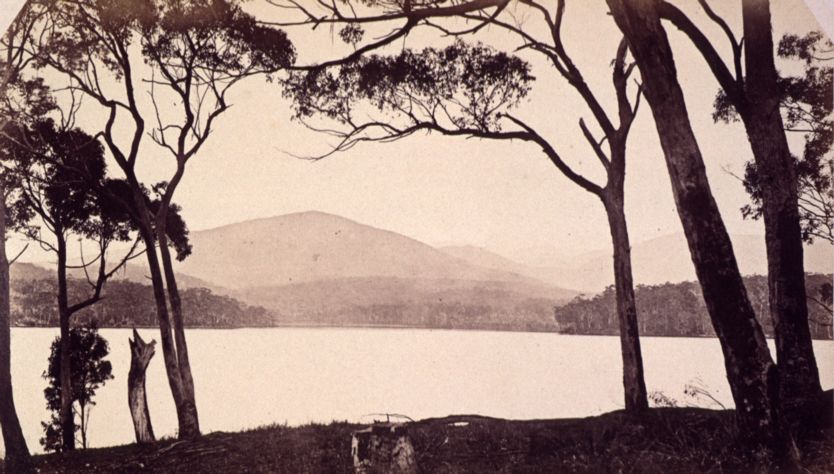
'[Lune] Sugar Loaf from the Narrows at Southport' (Samuel Clifford photo, Crowther Collection, State Library of Tasmania)
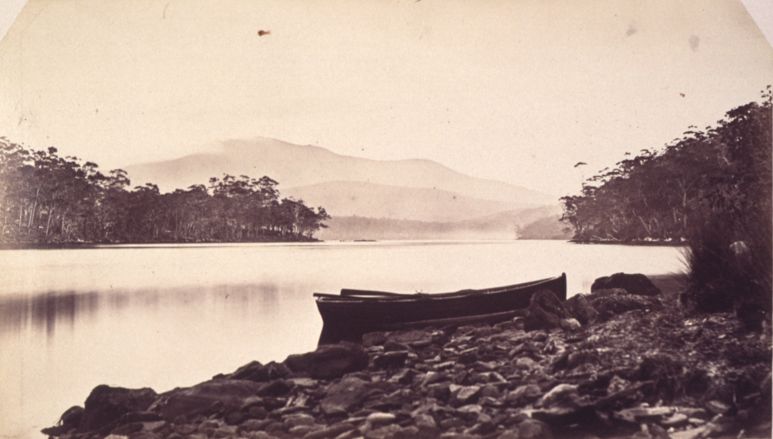
'Adamsons Peak from the Narrows at Southport'. (Samuel Clifford photo, Crowther Collection, State Library of Tasmania)
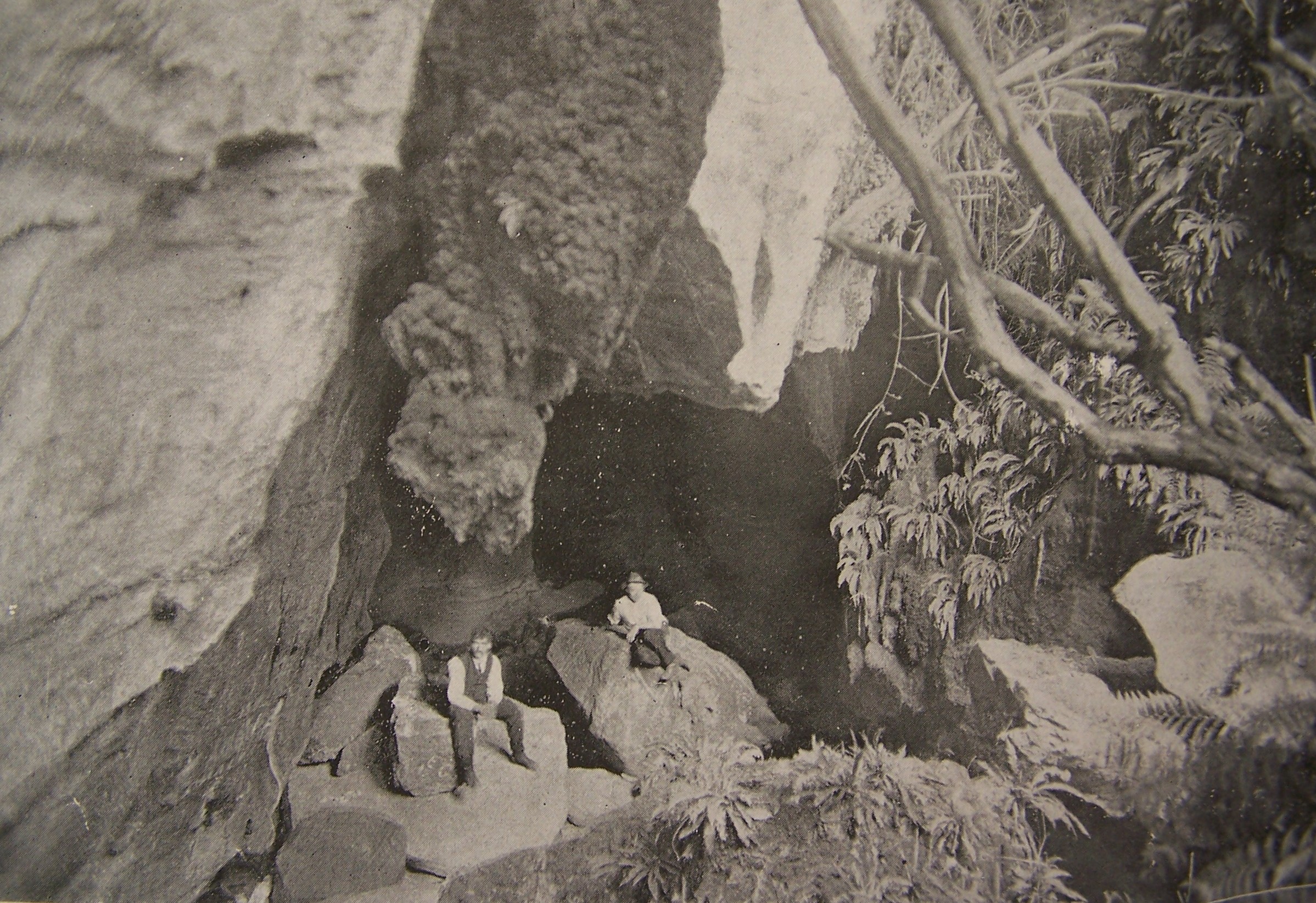
Entrance to Mystery Creek Cave, JW Beattie photo from Weekly Courier newspaper 6-7-1914

A cruise party aboard SS Huon in 1907 (Mike Simco Collection)
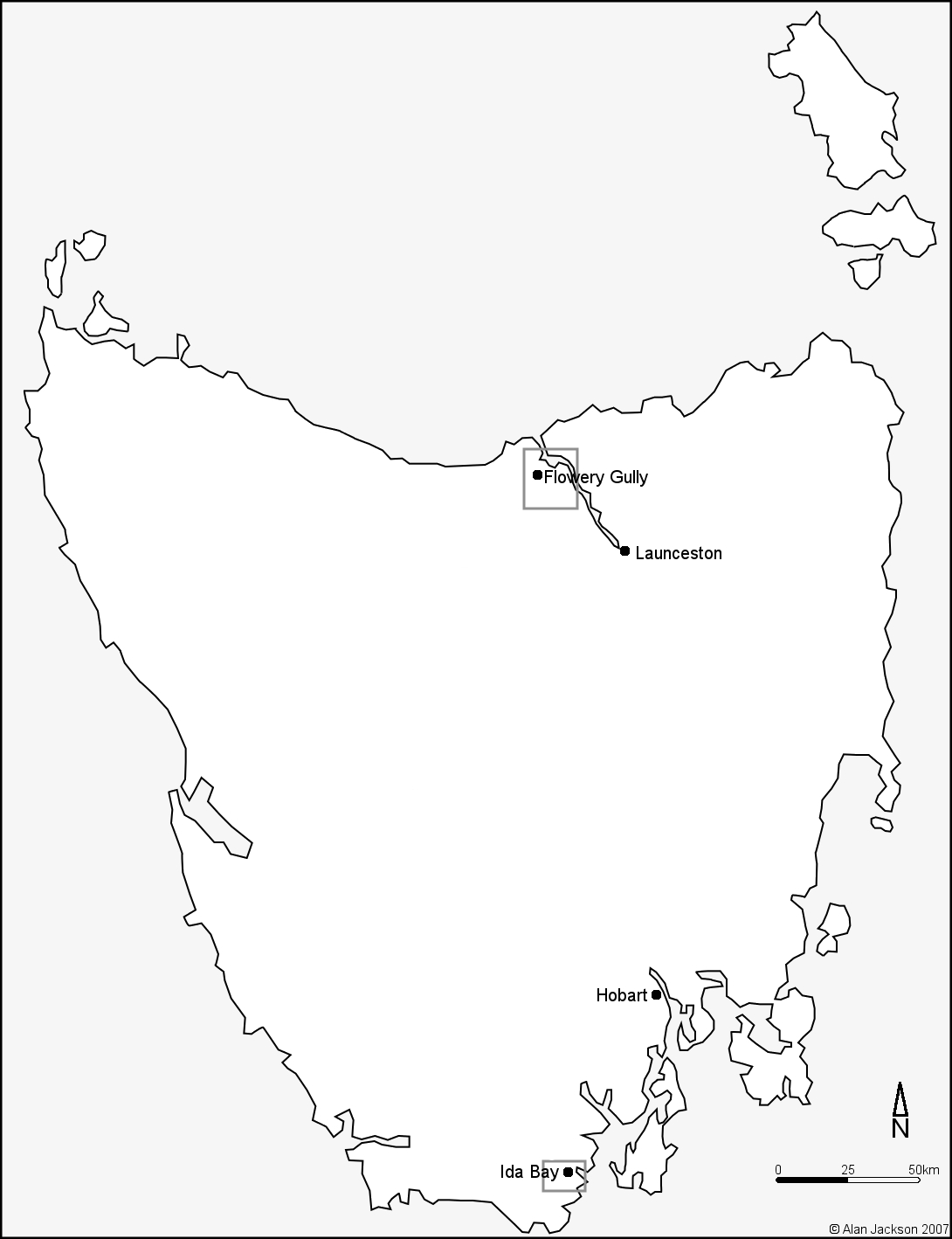
Overview map of Tasmanian cruises of the 1890s. (Alan Jackson)
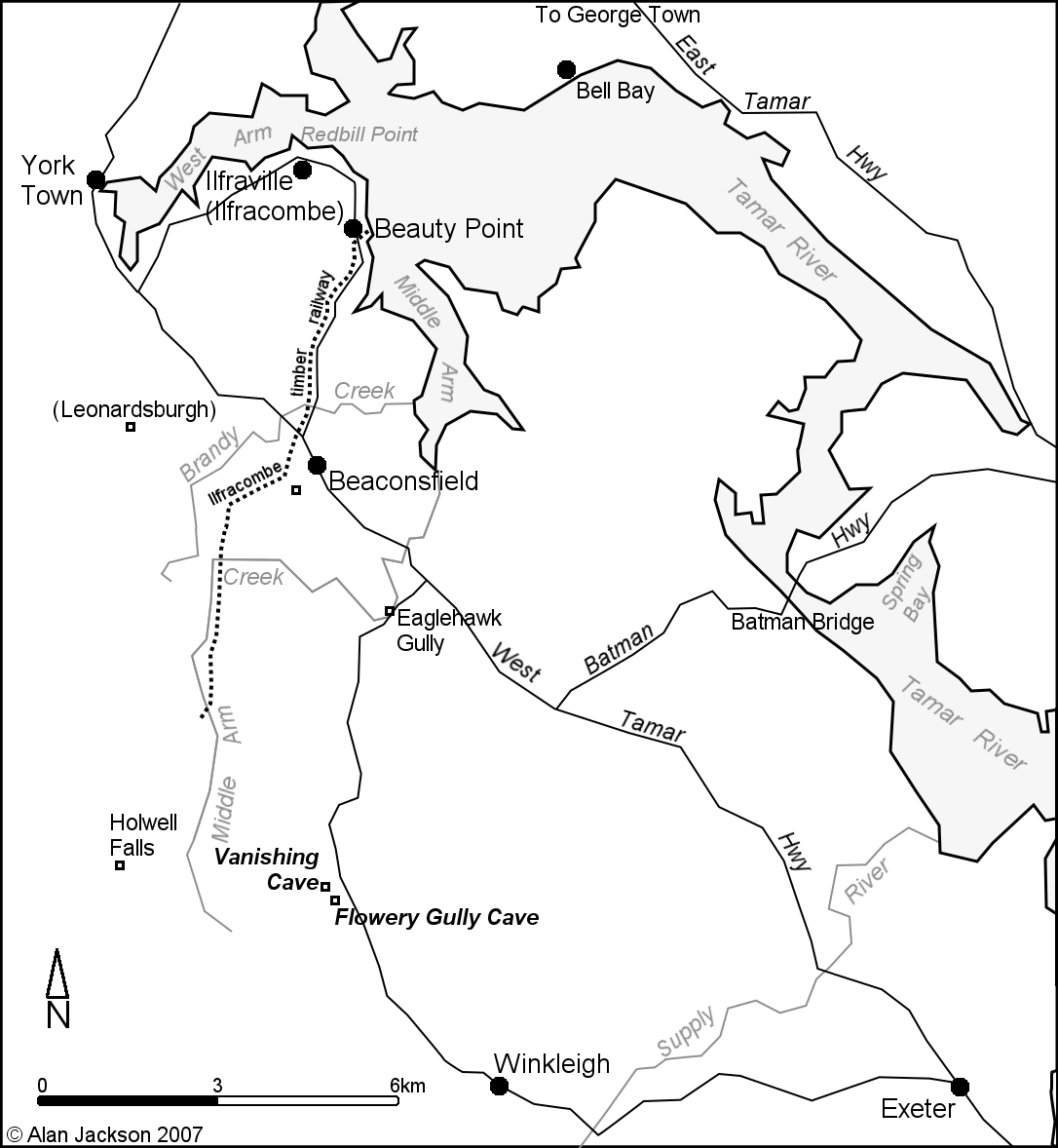
Ida Bay Caves area (Alan Jackson)
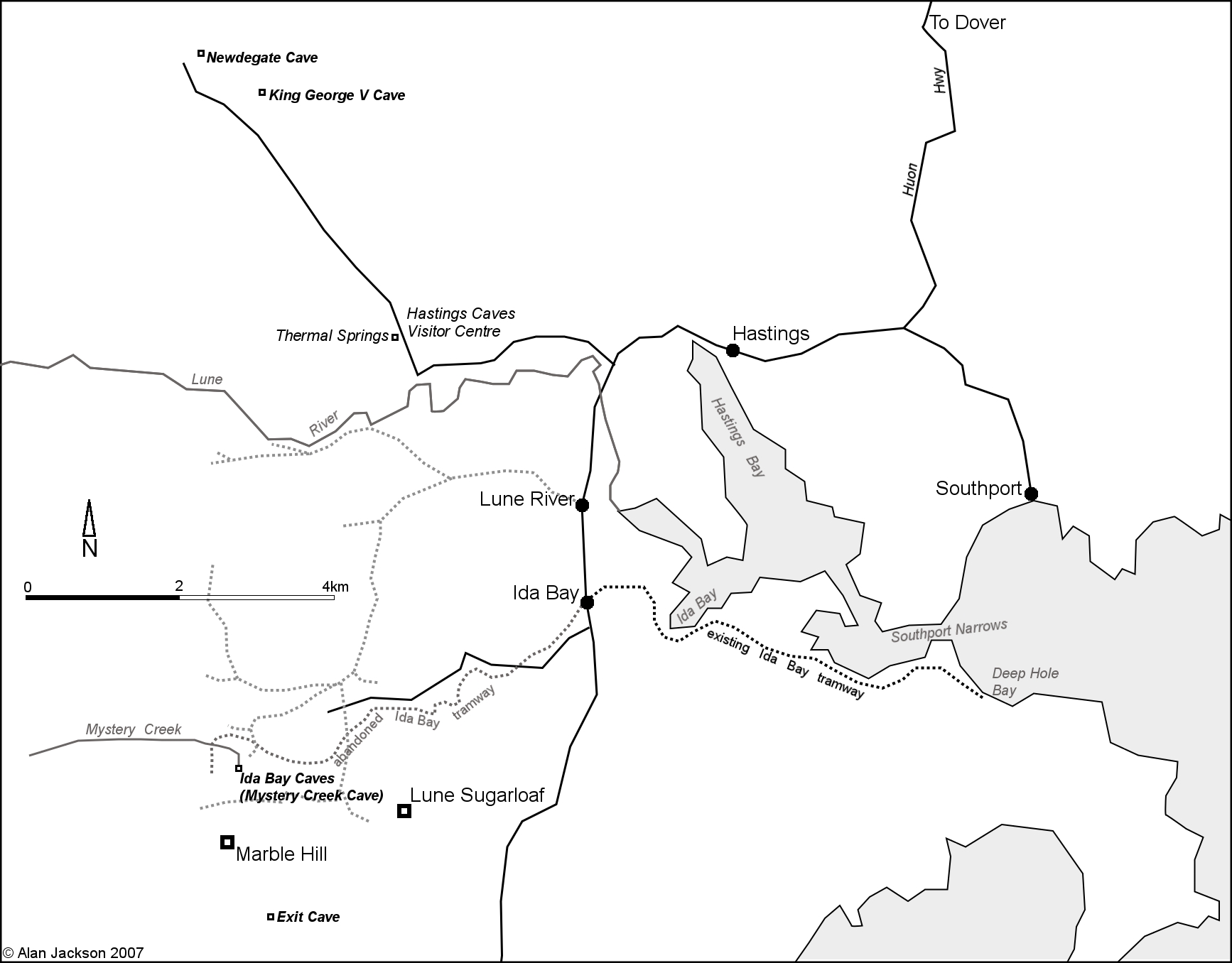
Flowery Gully Cave area - Beaconsfield area (Alan Jackson)
1 'At Hudson's [Flowery Gully] Caves, Beaconsfield', contained in a letter from John Wat Tyler to Henry Dobson 9 March 1893, PD1/60, file no.103 'Correspondence Records 1892-6' (Archives Office of Tasmania)
2 See, for example, Frank Whitcombe, Guide to Buchan Caves and Gippsland Lakes, Cunninghame Progressive Association, Cunninghame (now Lakes Entrance), 1908
3 See Jim Davidson and Peter Spearitt, Holiday Business: Tourism in Australia Since 1870, Melbourne University Press, 2000, pp.24-38.
4 Tim Bonyhady, in The Colonial Earth, Melbourne University Press, 2000, pp.102-12, discusses efforts to exclude working-class excursionists from Victoria's Ferntree Gully resort. For a Tasmanian example of the outcry against Sunday excursions, see 'Scottsdale' and 'Sunday Excursion Train to Scottsdale', Daily Telegraph (Launceston) 16 August 1889.
5 David Young, Making Crime Pay: the Evolution of Convict Tourism in Tasmania, Tasmanian Historical Research Association, Hobart, 1996, p.58
6 Union Steam Ship Company's Tasmanian Guide for Visitors to Tasmania, Launceston, 1891, p.63; 'The Queen's [sic] Caves, Ida Bay', Tasmanian Mail 20 February 1892, p.34
7 'The Queen's [sic] Caves, Ida Bay', Tasmanian Mail 20 February 1892, p.34. EG Innes, District Surveyor for Huon, in Survey Department Annual Report 1890-1, Parliamentary Paper 72/1891, p.16, recorded the discovery of limestone on the southern side of the Lune River and that 'a large area has been pegged off for mining purposes'.
8 'Hastings', Daily Telegraph (Launceston) 10 April 1891, p.4
9 For a discussion of the sublime, see Trevor R Shaw, History of Cave Science: the Exploration and Study of Limestone Caves to 1900, 2nd edn, Sydney Speleological Society, Sydney, 1992, p.238; and Rosalind Williams, Notes on the Underground: An Essay on Technology, Society, and the Imagination, MIT Press, Cambridge, Mass, 1990, p.86.
10 Musicological Society of Australia Newsletter, no.63, September 2005, www.msa.org.au/MSA_Newsletter63.htm
11 'Southport Caves', Papers and Proceedings of the Royal Society of Tasmania, 1891, pp.x-xi
12 'The Glow Worm Caves of Tasmania', Scientific American 23 November 1895, p.332
13 'The Queen's [sic] Caves, Ida Bay, Tasmanian Mail 20 February 1892, p.34
14 'The Queen's [sic] Caves, Ida Bay: Fine Marble Cliffs', Hobart Mercury 25 May 1891
15 'The Queen's [sic] Caves, Ida Bay, Tasmanian Mail 20 February 1892, p.34
16 'The Queen's [sic] Caves, Ida Bay', Tasmanian Mail 20 February 1892, p.34; 'Ida Bay Caves', Hobart Mercury 30 January 1893
17 'Ida Bay Caves', Mercury (Hobart) 23 January 1893, p.2
18 For the timber tramway, see Miranda Morris-Nunn and CB Tassell, Tamar Valley Industrial Heritage: a Survey, Australian Heritage Commission and Queen Victoria Museum, 1984, pp.11-3. For Hudson as discoverer, see 'At Hudson's [Flowery Gully] Caves, Beaconsfield', contained in a letter from John Wat Tyler to Henry Dobson 9 March 1893, PD1/60, file no.103 'Correspondence Records 1892-6' (Archives Office of Tasmania).
19 'Mr Tyler's Russell Falls Excursion Party', Mercury (Hobart) 27 February 1890, p.2
20 Peter MacFie, Mt Field: The Evolution of Tasmania's First National Park 1830-1960: Draft, Department of Parks, Wildlife and Heritage, Hobart, 1992, p.29
21 'Current Topics', Examiner (Launceston) 2 October 1892, p.3
22 'At Hudson's [Flowery Gully] Caves, Beaconsfield', contained in a letter from John Wat Tyler to Henry Dobson 9 March 1893, PD1/60, file no.103 'Correspondence Records 1892-6' (Archives Office of Tasmania)
23 John Wat Tyler to Henry Dobson 11 May 1893, PD1/60, file no.103 'Correspondence Records 1892-6' (Archives Office of Tasmania)
24 John Wat Tyler to Henry Dobson 9 March 1893, PD1/60, file no.103 'Correspondence Records 1892-6' (Archives Office of Tasmania)
25 'One of Your Many Visitors', 'The Ida Bay Caves', Mercury (Hobart) 2 January 1893
26 'Ida Bay Caves', Mercury (Hobart) 25 January 1893, p.2
27 Advert for Ida Bay Caves cruise, Mercury (Hobart) 28 February 1893, p.4; 'Ida Bay Caves', Mercury (Hobart) 22 February 1893, p.2
28 'Ida Bay Caves', Mercury (Hobart) 30 January 1893
29 'Ida Bay Caves', Mercury (Hobart) 30 January 1893; 'Ida Bay Caves', Mercury (Hobart) 23 January 1893, p.2
30 'Ida Bay Caves', Mercury (Hobart) 4 February 1893, p.3; advert, Mercury (Hobart) 22 February 1893, p.4
31 'Ida Bay Caves', Mercury (Hobart) 22 February 1893, p.2
32 Advert for 'Chudleigh Caves' railway excursion, Examiner (Launceston) 2 November 1894, p.4
33 'One of the Party', 'Tasmania's Beauty Spots: Excursion to Chudleigh Caves', Examiner (Launceston) 10 November 1894, p.5
34 Leventhorpe Hall, in 'Ida Bay and Jenolan Caves', Mercury (Hobart) 10 March 1893, p.3, details his correspondence with FJ Wilson.
35 'Ida Bay Caves', Mercury (Hobart) 9 February 1893
36 TB Moore diary entry 24 December 1900, Diary of Cutting Track from Hastings to Port Davey, ZM5631 (West Coast Pioneers' Museum, Zeehan, Tasmania)
37 See discussion in minutes of Deloraine Council for 1873 and 1879, MCC42/3/3 and MCC42/3/4 (Archives Office of Tasmania).
38 CA Morris, In Pursuit of the Travelling Man: a Study of Tasmanian Tourism to 1905, BA (Hons) thesis, University of Tasmania, Hobart, 1974, p.vi